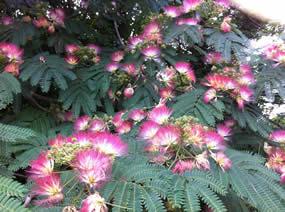Latin name: Albizia julibrissin
by Vancouver Island Master Gardeners Association
How very fortunate that we have this tree at Milner Gardens.
It’s very exotic looking in summer with its ferny leaves and its pink fluffy flower heads starting in June. It can tolerate drought and some winds. It’s very fast growing (60cm) a year. Ferny leaves are slow to leaf out in spring and are about 25cm long eventually leading up to gorgeous pink fluffy fragrant flower heads which develop in groups at the ends of the branches in early summer and bloom June to August. Literally dripping with nectar they attract bees, butterflies and hummingbirds.
Seed pods follow the flowers and persist into winter. They resemble flat bean pods approximately (12.7cm) long and yard clean up is recommended for the seedlings. The bark is smooth and grey, and pruning is best done in late winter or early spring.
In the northwest this tree is susceptible to Nectria canker, (Nectria cinnabarina) which leads to limb die back. The presence of brilliant pink to coral fruiting bodies on the surface of dead limbs are signs of the disease. Once it has got to this stage you must prune out the dead limbs.


Photo credit: Chinese Medicine Center(L), Milner Gardens (R)
|
Attribute |
Description |
|---|---|
|
Form: |
May be a large bush or a small tree. Mature trees grow into a v-shaped form |
|
Foliage: |
bi-pinnate ferny leaves |
|
Height/Width: |
4.572m high, 9.144 m high |
|
Hardiness Zone: |
6-9 |
|
Exposure: |
Full Sun |
|
Flower colour: |
Pink |
|
Leaf colour: |
green |
|
Flower time: |
July/August |
|
Preferred soil and Watering: |
Well drained moisture retentive soil but adaptable |
|
Other: |
Flowers and bark are used in traditional Chinese medicine |

